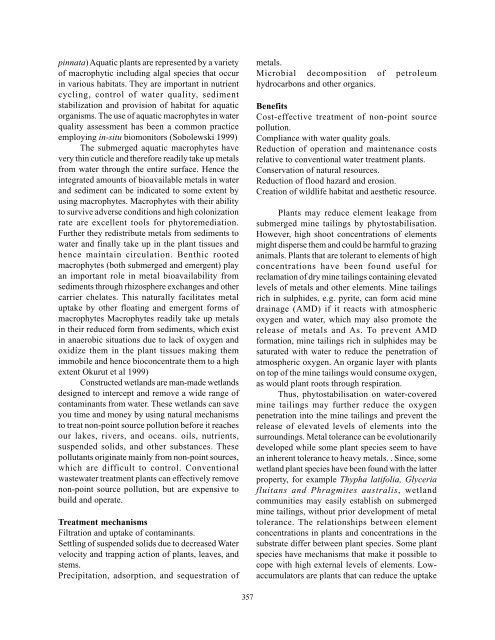Accepted Papers - 3.pdf - UNESCO
Accepted Papers - 3.pdf - UNESCO
Accepted Papers - 3.pdf - UNESCO
Create successful ePaper yourself
Turn your PDF publications into a flip-book with our unique Google optimized e-Paper software.
pinnata) Aquatic plants are represented by a variety<br />
of macrophytic including algal species that occur<br />
in various habitats. They are important in nutrient<br />
cycling, control of water quality, sediment<br />
stabilization and provision of habitat for aquatic<br />
organisms. The use of aquatic macrophytes in water<br />
quality assessment has been a common practice<br />
employing in-situ biomonitors (Sobolewski 1999)<br />
The submerged aquatic macrophytes have<br />
very thin cuticle and therefore readily take up metals<br />
from water through the entire surface. Hence the<br />
integrated amounts of bioavailable metals in water<br />
and sediment can be indicated to some extent by<br />
using macrophytes. Macrophytes with their ability<br />
to survive adverse conditions and high colonization<br />
rate are excellent tools for phytoremediation.<br />
Further they redistribute metals from sediments to<br />
water and finally take up in the plant tissues and<br />
hence maintain circulation. Benthic rooted<br />
macrophytes (both submerged and emergent) play<br />
an important role in metal bioavailability from<br />
sediments through rhizosphere exchanges and other<br />
carrier chelates. This naturally facilitates metal<br />
uptake by other floating and emergent forms of<br />
macrophytes Macrophytes readily take up metals<br />
in their reduced form from sediments, which exist<br />
in anaerobic situations due to lack of oxygen and<br />
oxidize them in the plant tissues making them<br />
immobile and hence bioconcentrate them to a high<br />
extent Okurut et al 1999)<br />
Constructed wetlands are man-made wetlands<br />
designed to intercept and remove a wide range of<br />
contaminants from water. These wetlands can save<br />
you time and money by using natural mechanisms<br />
to treat non-point source pollution before it reaches<br />
our lakes, rivers, and oceans. oils, nutrients,<br />
suspended solids, and other substances. These<br />
pollutants originate mainly from non-point sources,<br />
which are difficult to control. Conventional<br />
wastewater treatment plants can effectively remove<br />
non-point source pollution, but are expensive to<br />
build and operate.<br />
Treatment mechanisms<br />
Filtration and uptake of contaminants.<br />
Settling of suspended solids due to decreased Water<br />
velocity and trapping action of plants, leaves, and<br />
stems.<br />
Precipitation, adsorption, and sequestration of<br />
357<br />
metals.<br />
Microbial decomposition of petroleum<br />
hydrocarbons and other organics.<br />
Benefits<br />
Cost-effective treatment of non-point source<br />
pollution.<br />
Compliance with water quality goals.<br />
Reduction of operation and maintenance costs<br />
relative to conventional water treatment plants.<br />
Conservation of natural resources.<br />
Reduction of flood hazard and erosion.<br />
Creation of wildlife habitat and aesthetic resource.<br />
Plants may reduce element leakage from<br />
submerged mine tailings by phytostabilisation.<br />
However, high shoot concentrations of elements<br />
might disperse them and could be harmful to grazing<br />
animals. Plants that are tolerant to elements of high<br />
concentrations have been found useful for<br />
reclamation of dry mine tailings containing elevated<br />
levels of metals and other elements. Mine tailings<br />
rich in sulphides, e.g. pyrite, can form acid mine<br />
drainage (AMD) if it reacts with atmospheric<br />
oxygen and water, which may also promote the<br />
release of metals and As. To prevent AMD<br />
formation, mine tailings rich in sulphides may be<br />
saturated with water to reduce the penetration of<br />
atmospheric oxygen. An organic layer with plants<br />
on top of the mine tailings would consume oxygen,<br />
as would plant roots through respiration.<br />
Thus, phytostabilisation on water-covered<br />
mine tailings may further reduce the oxygen<br />
penetration into the mine tailings and prevent the<br />
release of elevated levels of elements into the<br />
surroundings. Metal tolerance can be evolutionarily<br />
developed while some plant species seem to have<br />
an inherent tolerance to heavy metals. . Since, some<br />
wetland plant species have been found with the latter<br />
property, for example Thypha latifolia, Glyceria<br />
fluitans and Phragmites australis, wetland<br />
communities may easily establish on submerged<br />
mine tailings, without prior development of metal<br />
tolerance. The relationships between element<br />
concentrations in plants and concentrations in the<br />
substrate differ between plant species. Some plant<br />
species have mechanisms that make it possible to<br />
cope with high external levels of elements. Lowaccumulators<br />
are plants that can reduce the uptake

















